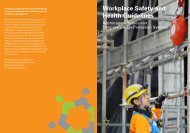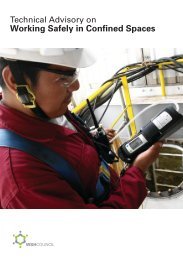Electrocution - Workplace Safety and Health Council
Electrocution - Workplace Safety and Health Council
Electrocution - Workplace Safety and Health Council
You also want an ePaper? Increase the reach of your titles
YUMPU automatically turns print PDFs into web optimized ePapers that Google loves.
PREFACE<br />
This compilation of case studies on fatalities in the construction industry<br />
is initiated by the <strong>Workplace</strong> <strong>Safety</strong> <strong>and</strong> <strong>Health</strong> <strong>Council</strong>, <strong>and</strong> put together<br />
by the WSH Construction Committee in collaboration with the Ministry<br />
of Manpower. This booklet depicts how the accidents occurred <strong>and</strong><br />
provides valuable learning points on how they may have been prevented.<br />
This is the first in a series of such booklets to be published.<br />
As much as the next few years promise to be exciting for the construction<br />
industry, they also pose a great challenge to the industry to maintain<br />
workplace safety <strong>and</strong> health. Construction sites have customarily been<br />
viewed as high-risk workplaces, which more often than not have a higher<br />
incidence of workplace fatalities. We must address this perception <strong>and</strong><br />
change the reality. While construction workers strive to complete a building<br />
or facility, it is important that they do not risk life <strong>and</strong> limb. It is crucial<br />
that these workers go home safely after work each day.<br />
This booklet of case studies offers insights to all in the industry on how<br />
these tragic accidents occurred, so that we may glean important, lifesaving<br />
lessons from the experience. In learning from our past mistakes,<br />
we can <strong>and</strong> must prevent these mishaps from happening again. Together<br />
with your help, we can transform construction sites into safe <strong>and</strong> healthy<br />
workplaces for our workers.<br />
Mr Lee Tzu Yang<br />
Chairman<br />
<strong>Workplace</strong> <strong>Safety</strong> <strong>and</strong> <strong>Health</strong> <strong>Council</strong>
Struck by Falling Objects<br />
Case 1 Pinned by a brick wall 64<br />
Case 2 Pinned by a collapsed roof slab 67<br />
Case 3 Struck by falling beams 70<br />
Case 4 Struck by steel beams 73<br />
Case 5 Struck by falling material in a trench 76<br />
Case 6 Struck by a crane boom 78<br />
Case 7 Hit by a collapsed wall 81<br />
Case 8 Hit by steel rebars 84<br />
Case 9 Buried under collapsed soil 87<br />
Case 10 Crushed by a collapsing boom 90<br />
Case 11 Struck by falling timber 92<br />
Case 12 Struck by a falling crane boom 95<br />
Case 13 Struck by a collapsed wall 97<br />
<strong>Electrocution</strong><br />
Case 1 <strong>Electrocution</strong> by a faulty residual circuit breaker 100<br />
Case 2 Killed by an exposed electrode holder 103<br />
Struck By or Against Objects / Machines<br />
Case 1 Hit by a scissors lift platform 108<br />
Case 2 Hit by a moving vehicle 111<br />
Case 3 Hit by a moving crane 114
ELECTROCUTION
CASE 1<br />
ELECTROCUTION BY A FAULTY RESIDUAL<br />
CIRCUIT BREAKER<br />
Description of Accident<br />
Deceased was assigned to plaster<br />
the ceiling of the ground floor at<br />
the loading/unloading bay of a<br />
factory under construction. A<br />
boom lift was used to enable him<br />
to reach the ceiling for plastering.<br />
He was found lying on the ground<br />
at the loading/unloading bay.<br />
Autopsy reported deceased died<br />
of electrocution.<br />
1. Deceased was found lying here<br />
2. Trench<br />
Causes <strong>and</strong> Contributing<br />
Factors<br />
• A pail of mixed cement <strong>and</strong><br />
a cement mixing tool were<br />
found at the scene. A portable<br />
extension socket outlet that<br />
was connected to the main<br />
switch board was also found<br />
at the scene.<br />
• Even though insulation tests<br />
performed on the cement mixing<br />
tool, extension socket outlet <strong>and</strong><br />
main switch board were<br />
satisfactory, the autopsy revealed<br />
that the cause of death was<br />
consistent with electrocution.<br />
1. Extension socket outlet<br />
2. A pail containing mixed cement<br />
3. Trench<br />
4. Deceased was found lying here<br />
5. Cement mixing tool<br />
100 <strong>Electrocution</strong>
• A residual circuit breaker (RCCB)<br />
installed at the main switch<br />
board was found to be defective.<br />
Root Cause Analysis<br />
Evaluation of loss<br />
Type of contact<br />
Immediate cause(s)<br />
Basic cause(s)<br />
Failure of SMS<br />
• One worker killed<br />
• Contact with electricity<br />
• Defective tools, equipment or materials<br />
• Inadequate maintenance<br />
• Maintenance regime<br />
Follow-up<br />
The occupier was instructed to implement the following<br />
improvements/measures at the worksite:<br />
• Electrical tools, appliances <strong>and</strong> circuit breakers installed on the<br />
main switch boards are to be inspected by a qualified electrician<br />
monthly to ensure that they are in good working condition.<br />
• All generator sets are to be inspected by a Licensed Electrical<br />
Worker before use.<br />
<strong>Electrocution</strong><br />
101
Recommendations<br />
Implement the use of Socket Outlet Assembly (SOA).<br />
Ensure all electrical tools, appliances <strong>and</strong> circuit breakers (including<br />
RCCB) installed on the main switch boards are inspected by a<br />
qualified electrician periodically to ascertain the working condition.<br />
Enforce the use of personal protective equipment.<br />
102 <strong>Electrocution</strong>
CASE 2<br />
KILLED BY AN EXPOSED ELECTRODE HOLDER<br />
Description of Accident<br />
A worker was carrying out welding<br />
work in a factory premises to<br />
erect a mezzanine floor.<br />
He was found dead on the metal<br />
structure of the mezzanine floor<br />
that was being erected. He was<br />
holding a welding electrode<br />
holder in his right h<strong>and</strong> <strong>and</strong> it<br />
was resting on his chest.<br />
The autopsy reported that the<br />
worker died of electrocution.<br />
Causes <strong>and</strong> Contributing<br />
Factors<br />
1.The deceased was found lying here<br />
2. The C channels<br />
3. The horizontal I-beam<br />
4. The isolator<br />
5. Welding cable<br />
6. The AC welding set<br />
• A metal jaw <strong>and</strong> part of the metal<br />
upper h<strong>and</strong>le of the electrode<br />
holder was exposed as the plastic<br />
insulation covering had<br />
broken off.<br />
• The worker was probably<br />
electrocuted when his body<br />
came into contact with the<br />
energised exposed metal part<br />
of the electrode holder.<br />
1. Part of the insulation covering for the<br />
upper h<strong>and</strong>le of the electrode holder<br />
had broken off, exposing the metal part<br />
2. The metal jaw of the electrode holder<br />
was exposed<br />
3. Welding electrode<br />
<strong>Electrocution</strong><br />
103
Root Cause Analysis<br />
Evaluation of loss<br />
Type of contact<br />
Immediate cause(s)<br />
Basic cause(s)<br />
Failure of SMS<br />
• One worker killed<br />
• Contact with electricity<br />
• Defective tools <strong>and</strong> equipment<br />
• Inadequate maintenance<br />
• Maintenance regime<br />
Follow-up<br />
A Stop Work Order was issued.<br />
The company was instructed to implement the following safety<br />
measures:<br />
• All AC arc welding sets to be fitted with low voltage<br />
shock preventors.<br />
• All electrode holders, welding cables, cable connectors to be<br />
inspected before use.<br />
• No welding work to be carried out in wet conditions.<br />
104 <strong>Electrocution</strong>
Recommendations<br />
Fit all AC arc welding sets with low voltage shock preventors.<br />
Inspect all electrode holders, welding cables <strong>and</strong> cable connectors<br />
before use.<br />
Conduct regular maintenance of all equipment.<br />
Ensure overall supervision of welding work.<br />
<strong>Electrocution</strong><br />
105
Published in June 2008 by the<br />
<strong>Workplace</strong> <strong>Safety</strong> <strong>and</strong> <strong>Health</strong><br />
<strong>Council</strong> in collaboration with<br />
the Ministry of Manpower.<br />
All rights reserved. This<br />
publication may not be<br />
reproduced or transmitted in<br />
any form or by any means,<br />
in whole or in part, without prior<br />
written permission. The<br />
information provided in this<br />
publication is accurate as at time<br />
of printing. All cases shared in this<br />
publication are meant for learning<br />
purposes only. The learning points<br />
for each case are not exhaustive<br />
<strong>and</strong> should not be taken to<br />
encapsulate all the responsibilities<br />
<strong>and</strong> obligations of the user of this<br />
publication under the law. The<br />
<strong>Workplace</strong> <strong>Safety</strong> <strong>and</strong> <strong>Health</strong><br />
<strong>Council</strong> does not accept any<br />
liability or responsibility to any<br />
party for losses or damage arising<br />
from following this publication.

















